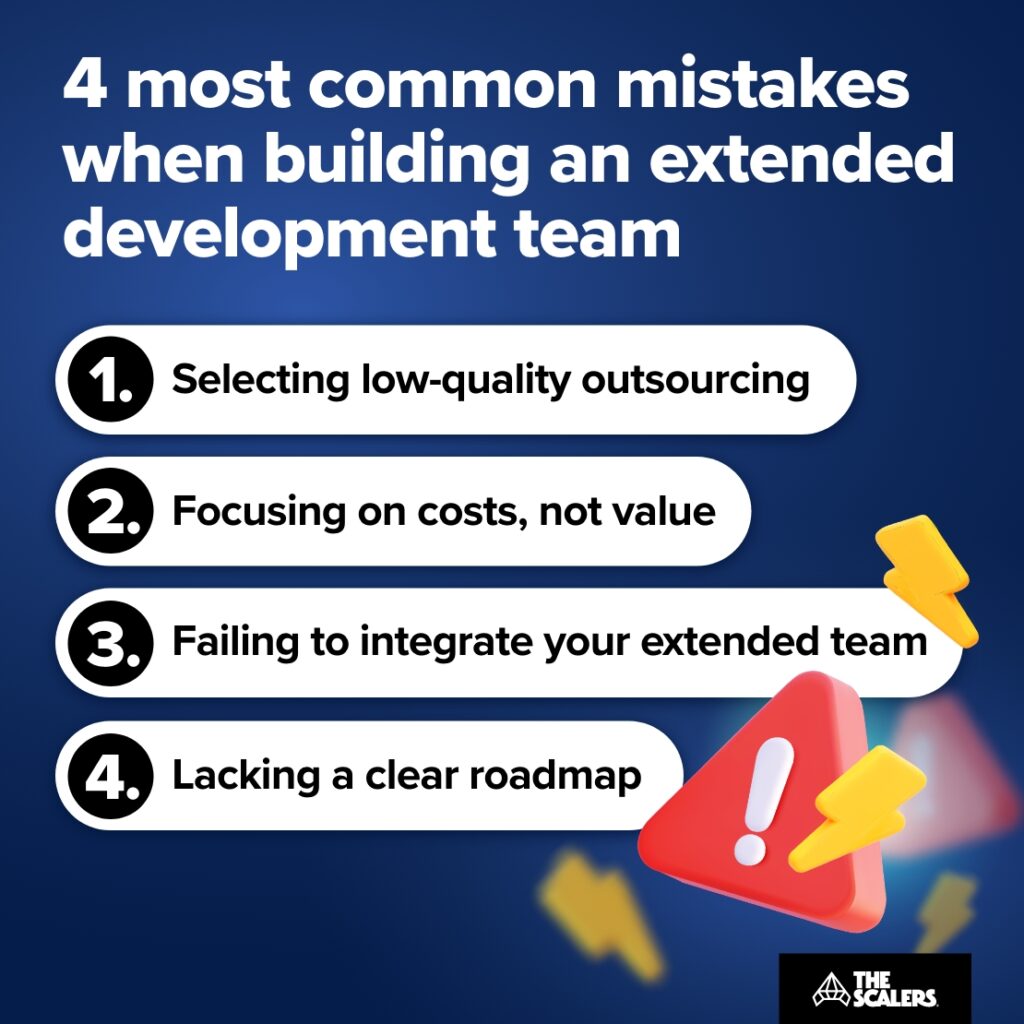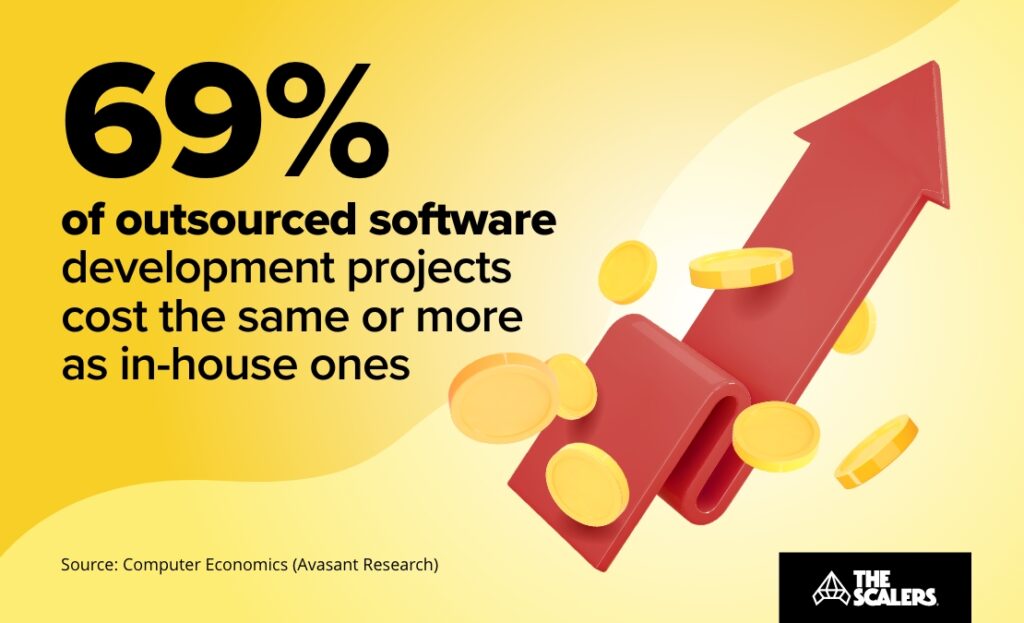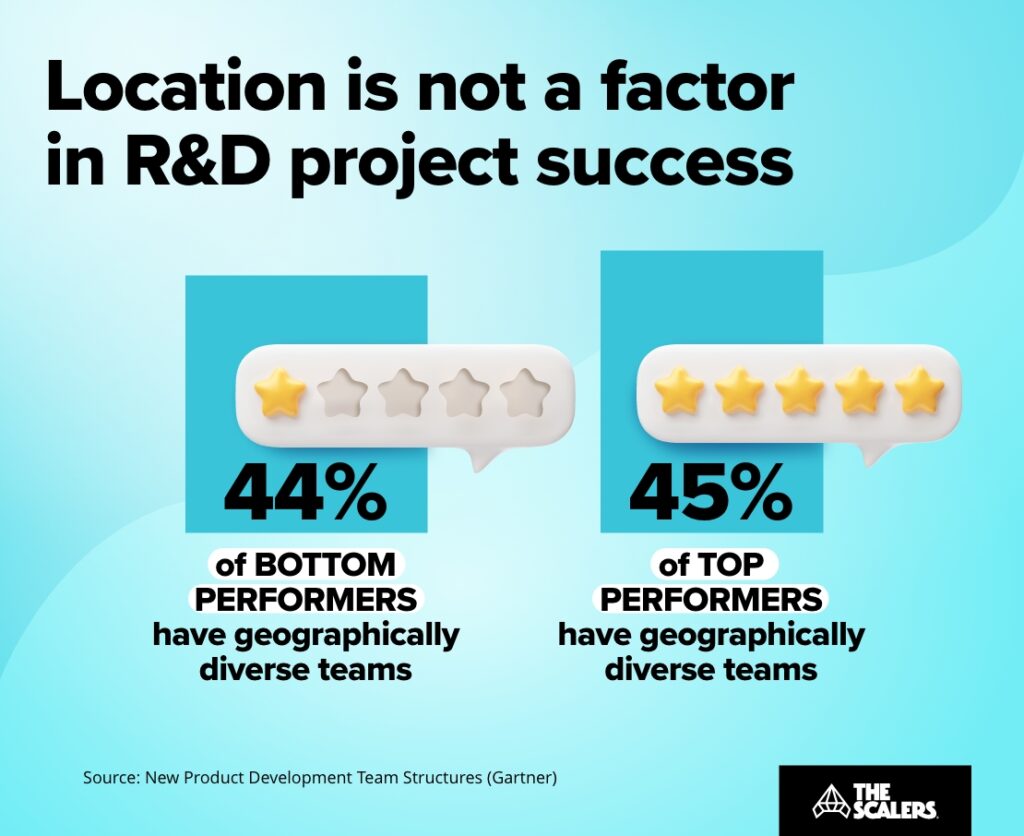4 mistakes CTOs must avoid when building extended development teams

So you’re thinking of extending your development team. You’re not alone.
In 2023, companies around the world spent $575.2 Billion on offshore IT services, according to a study by IMARC.
Unfortunately, not every extended development team project is successful. Many decision-makers fall into common traps that slow development, run over budget and suck up time fixing mistakes.
To ensure you don’t get derailed by these same missteps, we’ve prepared this article. It includes not only the mistakes but also actionable tips to help you avoid them.
If you follow it, you’ll be guaranteed to get a development team that helps not hinders your development roadmap.
But first, let’s make sure we’re on the same page.
What is an extended development team (and why you should want one)?
The extended team model is a way to scale development operations by adding additional team members in another location either full-time or part-time. It’s sometimes called staff augmentation but while staff argumentation can be for one developer, by definition a team has multiple members.
Team extensions can be for limited project-based work when you need a specific skill for a short time, or when you need to ramp up development to hit a pressing deadline. It’s more common, however, for team extensions to be a longer-term solution to offer continual support for a development team.
Dedicated team vs Staff augmentation vs Team extension
- Dedicated Team: a complete software development team including project managers provided by a third party working on a specific project
- Staff Augmentation: additional employees from a third-party provider to fill short-term skills gaps in an in-house team
- Team Extension: Multiple team members provided by a third party to scale an in-house development team for a single project or ongoing basis
What are the benefits of a team extension?
The exact benefits you can expect depend on the specifics of the model you adopt.
There are, however, some general benefits you can expect including faster hiring, access to niche skills, and lower overheads. These benefits provide strategic advantages for IT leaders to:
- hit development deadlines
- optimise their tech budgets
- cover short and long-term skills gaps
Some extended tech development teams provide additional benefits including extending development time by operating in other time zones and the extent of these benefits depends on which provider you partner with.

Discover how to scale development teams in 2023 and beyond
DOWNLOAD EBOOKWhen should you set up an external team?
Here are the five signs that you should at least consider setting up a software team extension.
- You need specific development skills you can’t find locally.
- You can’t hire enough developers of sufficient quality locally.
- You need to scale your development operations to get ahead of the competition.
- You want to add more diversity for more creative solutions.
- Your development goals outstrip your budget.
If any of these statements apply to your operations, gaining extended team members will help.
Okay, with that all out of the way, let’s make sure you are ready to avoid the most common mistakes.
What are the 4 most common extended development team mistakes?
While there are many pitfalls companies can fall into once they decide to extend their IT teams, some are more common and more costly than others.
After more than 10 years of building dedicated tech teams for companies based all over the world, the following four are the most common mistakes partners have befallen before they approach us.

1: Outsourcing your development processes
If you want to augment your existing development team, it’s crucial to look beyond a temporary arrangement that can work for a one-off project.
Building an extended team is a permanent solution, and the engineers that you hire become permanent employees of your business that are in it for the long haul — and that’s the biggest difference between outsourcing and building a dedicated team.
How is building an extended development team different?
When working with an outsourcing vendor, you get access to a team of engineers who are hired by the outsourcing company, for the outsourcing company.
They are NOT your employees, which means that they aren’t invested in your business.
Often, they’re working on multiple projects for multiple clients at the same time. This is especially true of senior developers and those with niche skills. With little to no focus on your business, more often than not, you’re left with delays, substandard software, no team and no internal knowledge of the work.
An extended software team, on the other hand, is yours, in every sense of the word. They work for you, they believe in the vision of your business, and their goal is simple — to help you grow your business by building software.

Can’t find the skills you need at home? Stop searching and start scaling
LEARN MORE

We, at The Scalers, believe that if your core business is software development, then it should stay within your organisation and not in the hands of an outsourcing vendor that you don’t have control over. And sure, outsourcing might seem like a simpler and cheaper option, but it won’t give you the long-term collaboration crucial for building great software.
2: Evaluating the cost, rather than the value
How much will this cost?
It’s a key factor for any business in every decision; as it should be.
While cost is a glass ceiling that somehow can never be breached, fixating too much on the price can mean that you’re not looking at the value proposition of the deal.
The result?
Many businesses, when given a choice, will choose the less expensive result.
Not surprisingly, this is usually the wrong choice because lower rates don’t always mean getting the better end of the bargain.


The lowest cost almost inevitably means the lowest quality. Not to mention hidden costs that can end up spiralling out of control. Outsourcing, for instance, offers services at very low prices but is a breeding ground for both issues. The developers are less experienced, work on multiple projects, run behind schedule and the fine print of contracts often contains ticking time bombs.

Focus on value for the cost-optimal solution
Keep the price aside for a moment, and focus on asking them the bigger question — what value can they bring to the table?
Assess their portfolios, their expertise, and how the higher costs can translate to higher productivity and success rate. Higher initial rates without hidden costs may not only be cheaper in the long run but also bring higher returns.
If the facts and figures laid out don’t speak for themselves, then you’re better off not making that deal.
3: Not involving your extended team members enough
When you have a software team extension, it’s important to remember that they’re as much a part of your organisation as your local team is. The only real difference here is that they sit somewhere else, in a different office space.
Depriving your remote team of important business knowledge, keeping them away from team calls, or not letting them voice their opinion or feedback can lead to them feeling isolated, unappreciated, and unrecognised. Your extended team will no longer have a 360-degree comprehensive view of the business, the project at hand, and the larger goals of your business, which will result in unoptimised software solutions. In turn, this can affect their morale and motivation and hinder productivity.
So what can you do?
A study conducted by Harvard Business School showed employees who were recognised and appreciated by their superiors were more than 40% more engaged than those who weren’t.
It’s that simple. Make sure to include your extended team in any important discussions, ask them for ideas, brainstorm together, appreciate their efforts, and collaborate on day-to-day tasks.

Treat your extended team no differently than your remote team, and see the magic happen.

How we helped a FinTech scale to a 450+ person R&D Centre in Bangalore
DOWNLOAD CASE STUDY4: Not establishing a clear roadmap
Imagine building a stellar extended development team, all ready to work on building software, but you’re not able to assign the right tasks to them because you didn’t plan well in advance. Sounds like trouble, right?
An integral part of collaborating with an offshore provider and building a remote team is planning.

Before you even partner with an offshore development company, it’s essential to put together a clear roadmap — a set of actionable steps for the near future. Rushing into a collaboration headlong and building requirements on the fly will lead to chaos and confusion, rather than increased productivity.
While it can be appealing to build requirements on the fly, you still need to make sure that you have enough work for your remote team for the next one to two development cycles, at the very least.
What is the best way to build an extended development team?
From our experience of over 10 years of building more than 80 offshore teams for our partners, we’ve established a proven model that avoids the pitfalls above. This proven approach has provided value-adding team extensions for partners whose previous efforts failed.
Here’s a breakdown of the key steps
- Identify your needs and goals: What roles are you looking for? What does your roadmap look like? Where are the bottlenecks in hiring and development?
- Identify the right extension approach for your business: are you looking for a short-term project or a long-term product approach?
- Draw up a list of possible partners: Don’t settle for the first partner you find. Get a selection of candidates to ensure you make the right choice.
- Vet possible partners thoroughly: Check their models, pricing structure, certification and case studies. Ask them challenging questions and notice their approach to communication — it will show you how they will operate in the future.
- Make an informed decision: Go back to your original assessment and check how each partner holds up.
- Integrate your team extension fully: This will be far easier with a high-value partner who not only finds suitable employees, but also makes sure they are onboarded into your systems, workflows, and culture then keeps them engaged daily.
If you want more details, check out this ultimate guide on how to build an offshore team.
Conclusion
When done right, expanding your development team is the most cost-effective way to accelerate your product delivery and overcome talent shortages and long hiring times as well. When done wrongly by making the mistakes above, it becomes an expensive hindrance to your development goals.
Make sure you pick the right path.
If you’re looking to build an extended software development team, reach out to us by filling out the contact form. As experts in building the best engineering teams in India, we can help you set up the team that you’re looking for.















